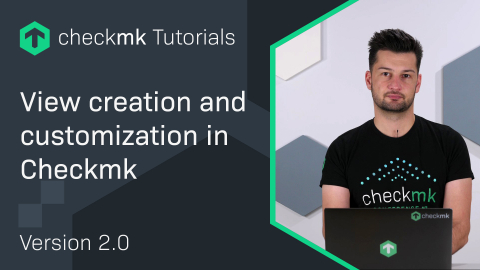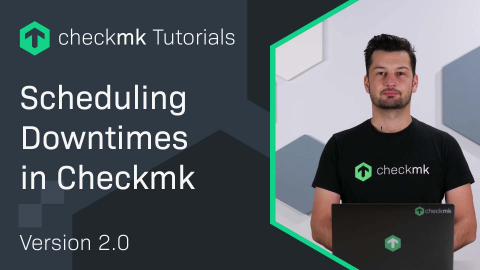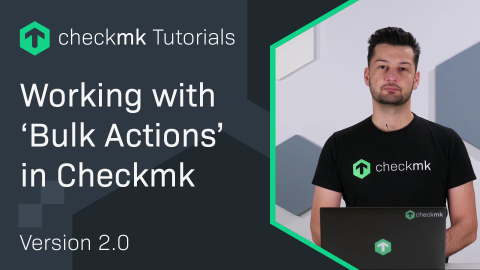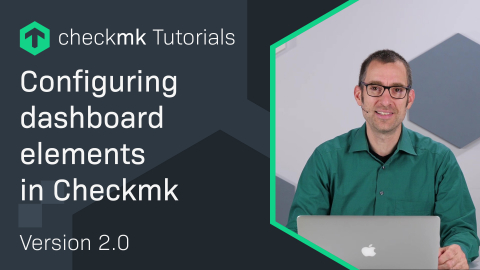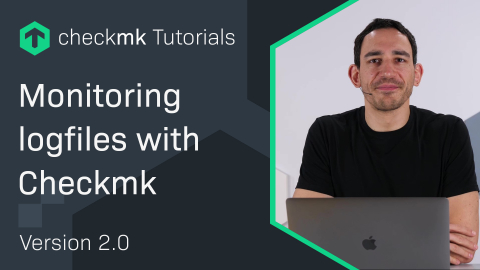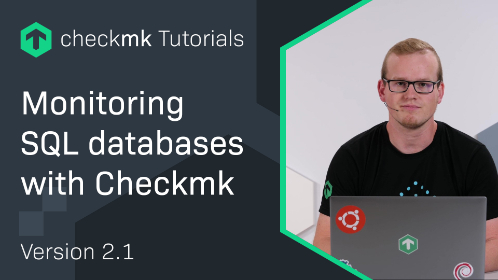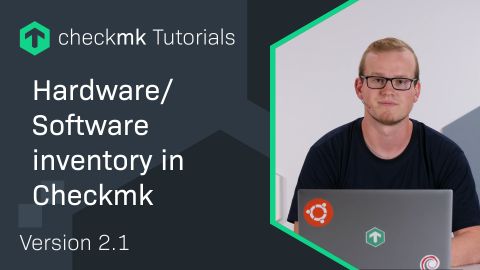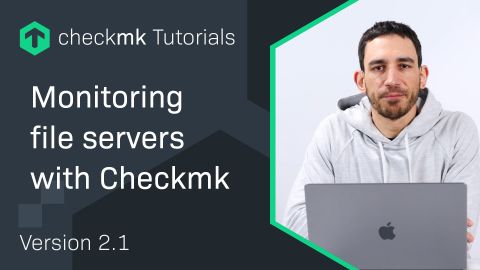Ep. 18: Erstellen und Anpassen von Dashboards in Checkmk
| [0:00:00] | Welcome to this Checkmk video tutorial. Today we'll speak about dashboards, dashboards in general and also, of course, how you can create your own dashboard. |
| [0:00:10] | Checkmk has brought quite a lot of new features and improvements in the version 2.0. We completely reworked the user interface made everything look more shiny and nice to use. |
| [0:00:22] | Also we introduced a couple of new elements that you can put on your dashboards and how this works. We'll see now. Let's get started. |
| [0:00:41] | So, what is a dashboard? When you log in to Checkmk, you'll see the Main dashboard. The Main dashboard consists of several boxes like Host statistics, Service statistics, maybe some metrics, performance graphs and so on. |
| [0:00:53] | So, generally it's a canvas where in boxes, there is arranged information. And what information this is, you can decide by creating your own dashboard. Maybe it's about one specific application or a network operating center or maybe just one host. And how this can be done? We'll see now. |
| [0:01:17] | As a first example, I want to add a graph of a single metric so I choose Add, Single metric graph. And here in all these fields, I just need three things. |
| [0:01:32] | First, the Hostname. I choose demo.checkmk.com. It's one of the servers that is monitored here on this system. And the Service is CPU load. |
| [0:01:44] | And when I have filled on these two fields, the Metric selection just shows the metrics of this service. In this case, I choose the first one it's CPU load average of last minute. And that's all I need. I can save. And you see we get our first element on the dashboard. |
| [0:02:03] | If you want, you can now move the element around or you can resize it. And if you're happy with that, simply press this icon to leave the layout mode and go back to the normal view. |
| [0:02:17] | One problem that you can see here is maybe that the title of this element doesn't show the host name that you have taken the metric from. |
| [0:02:28] | But you can edit that. Simply re-enter the layout mode, press this icon to enter the settings of the element, and here is a field called Custom title. And here I can, for example, write CPU load of demo. Save. Leave layout mode and you see you get the title CPU load of demo here at the top of the element. |
| [0:02:56] | As a second example, I now want to add a graph of a service that's not just a single metric but a graph with several metrics that you know from all the services in Checkmk. |
| [0:03:08] | As an example, let's go to the demo host and choose the service CPU utilization. As you can see here's a graph that consists of five metrics of user system I always see in total. And, so it's not a single metric. It's a complete graph template. And that I want to add to the dashboard. |
| [0:03:35] | So, let's go back to our dashboard. I go to MonItor and as you now can see our dashboard has been sorted into workplace and is available in the monitor menu. |
| [0:03:46] | So, I select the dashboard and now I choose Add, and this time we add a performance graph. This time again I need to select the Hostname, the Service description, this time CPU utilization. |
| [0:04:06] | And now I don't select a metric but one of the predefined graph templates. In this case, there's just one, it's called CPU utilization. And I save it and as you can see we have a second graph here. If you want to add such a graph to your dashboard, there's a much more convenient way. |
| [0:04:27] | Let's go back to the monitor host. And maybe this time we choose the service Memory. And you see there's lots of graphs here. And let's for example take the RAM and SWAP overview. And here in the menu you see Add to dashboard. I choose My first dashboard and now this graph is added to the dashboard. |
| [0:04:55] | You might be confused here because no new element has appeared. The reason is that new elements always appear at the top left corner. So, if you move this graph around, you will see that the other two are still here. |
| [0:05:07] | I place it somewhere. Leave the layout mode and you see we have now three graphs. Now let's add a different kind of element to the dashboard. This time, I just want to show a single metric without any historic values. |
| [0:05:22] | So again, I choose the Hostname. I choose a service maybe let's take the file system usage this time. Metric is Used file system percent. |
| [0:05:34] | And here I disable the historic values and save this and get one big number. Let's make this a bit smaller. Maybe move it here. Leave layout mode and as you can see we have one single metric without any historic values here. Okay, so maybe I want a second of these for a different service. |
| [0:06:04] | So, what I can do now is I press the middle icon in order to clone it. I get an exact copy of it. Let's move it here. Let's make it a bit smaller. |
| [0:06:16] | And now I will change the service that's being displayed. This time, let's maybe use something from the Memory. Let's display the Free RAM. Save this. And as you can see now we have two metrics being displayed. |
| [0:06:37] | Okay, so now we have a dashboard with some information. And yeah, let's face it, it's still a bit ugly because it's not very cleaned up. |
| [0:06:47] | So let's go back to layout mode. Let's clean up this a bit maybe make this a bit smaller, move that here, with this one here, and make it nicely fit our screen. And let's have a look. Looks better. Well, while this looks pretty nice, there's still a problem. |
| [0:07:22] | If I have a smaller screen or if I simply increase the zoom in the browser, you see some of the information will be cut off and not fit into the dashboard anymore. Or if I remove the sidebar, we have a different thing. We have lots of nice base that's not being used by the graphs. |
| [0:07:41] | The dashboards that come with Checkmk do not have that problem. They perfectly adapt to the actual screen size. And now I show you how you can improve your dashboard that it also uses the screen size. |
| [0:07:53] | Okay, so let's enter layout mode again. And first, let's start with the element at the bottom. You see there are two green buttons. |
| [0:08:02] |
The first one is labeled manual width. If you click once on it, it changes to auto width and now the width is automatic. You can see that there's no possibility anymore to change the width here with the mouse. |
| [0:08:21] | So, if I, for example, remove the sidebar, you see, that this element takes over all the available width. Or if I increase the browser zoom, you can see that it's getting more and more width. |
| [0:08:39] | What's still missing is the height. But as you can see, there's a second button called manual height. Let's change that to auto height and now this element will take over all height and width that's available. So, next let's address the small element. |
| [0:08:57] | It doesn't make much sense to make them wider since the number is being visible anyway. But what we want to achieve is that they are placed at the right border of the area. So, I, of course, I can move this one here to the right. |
| [0:09:13] | But now if I make the screen smaller, it's going to be cut off. So, that's not a good solution. |
| [0:09:23] | The better solution is to change the anchoring point which is one of the four corners. If you click on this corner, you see, that now it will stick to that position from the right side of the screen. So, if i place it now to the absolute corner, you see, it will stick at the corner. |
| [0:09:48] | So, let's make the same with the second element here. I put the anchor on the right side. I move it here. And now these two nicely stick to the right side of the screen. |
| [0:09:59] | So, the next step is simply choose automatic width also for this element. And as you can see, this will take over all the available width that is not being used by these small elements. |
| [0:10:18] | Okay, so now let's deal with this middle element. Of course, we can make manual automatic width which is nice because now it uses all the available width. |
| [0:10:29] | But we want these bottom two elements to share the remaining screen height. So, because it's not very useful that one of the graphs gets all the height and the other remains very very tiny. |
| [0:10:43] | So, what we can make is change that one to automatic height. But it still doesn't work. What's the reason? The reason is the anchor of the bottom element is at the top left, so it always begins at this absolute position. |
| [0:11:02] | What we need to change is to move this anchor to the bottom left. So these both grow towards each other. And they by that way share all the width. And every element gets 50 percent of the width which is much more useful. So here, you see, I can leave the layout mode. And now you see that we have a nice self-adapting dashboard. |
| [0:11:27] | So, thanks for watching. I hope this was helpful and see you next time. |
Wollen Sie mehr über Checkmk erfahren? Dann nehmen Sie an unserem Webinar "Einführung in Checkmk" teil!












